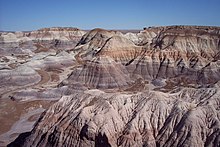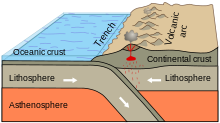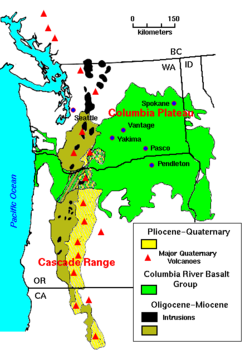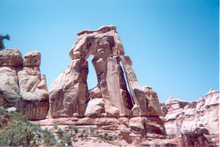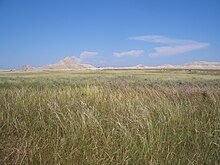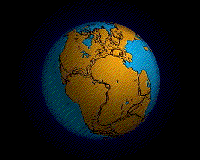A map of the Colorado Plateau.
The Four Corners Monument is where the states of Colorado, New Mexico, Arizona, and Utah meet. (The states are listed in clockwise order.)
The Colorado Plateau, also known as the Colorado Plateau Province, is a physiographic and desert region of the Intermontane Plateaus, roughly centered on the Four Corners region of the southwestern United States. This province covers an area of 336,700 km2 (130,000 mi2) within western Colorado, northwestern New Mexico, southern and eastern Utah, and northern Arizona. About 90% of the area is drained by the Colorado River and its main tributaries: the Green, San Juan, and Little Colorado. Most of the remainder of the plateau is drained by the Rio Grande and its tributaries.
The Colorado Plateau is largely made up of high desert, with
scattered areas of forests. In the southwest corner of the Colorado
Plateau lies the Grand Canyon
of the Colorado River. Much of the Plateau's landscape is related, in
both appearance and geologic history, to the Grand Canyon. The nickname
"Red Rock Country" suggests the brightly colored rock left bare to the
view by dryness and erosion. Domes, hoodoos, fins, reefs, river narrows, natural bridges, and slot canyons are only some of the additional features typical of the Plateau.
The Colorado Plateau has the greatest concentration of U.S. National Park Service (NPS) units in the country outside the Washington, DC metropolitan area. Among its nine National Parks are Grand Canyon, Zion, Bryce Canyon, Capitol Reef, Canyonlands, Arches, Mesa Verde, and Petrified Forest. Among its 18 National Monuments are Bears Ears, Rainbow Bridge, Dinosaur, Hovenweep, Wupatki, Sunset Crater Volcano, Grand Staircase-Escalante, Natural Bridges, Canyons of the Ancients, Chaco Culture National Historical Park and the Colorado National Monument.
Geography
The Four Corners region and the Colorado Plateau. Click image to see state lines.
The Book Cliffs of western Colorado.
The Green River runs north to south from Wyoming, briefly through Colorado, and converges with the Colorado River in southeastern Utah.
Sunset in Ojito Wilderness, near Albuquerque, NM
This province is bounded by the Rocky Mountains in Colorado, and by the Uinta Mountains and Wasatch Mountains branches of the Rockies in northern and central Utah. It is also bounded by the Rio Grande Rift, Mogollon Rim and the Basin and Range Province. Isolated ranges of the Southern Rocky Mountains such as the San Juan Mountains in Colorado and the La Sal Mountains in Utah intermix into the central and southern parts of the Colorado Plateau.
It is composed of six sections:
- Uinta Basin Section
- High Plateaus Section
- Grand Canyon Section
- Canyon Lands Section
- Navajo Section
- Datil Section
As the name implies, the High Plateaus Section is, on average, the highest section. North-south trending normal faults that include the Hurricane, Sevier, Grand Wash, and Paunsaugunt separate the section's component plateaus.
This fault pattern is caused by the tensional forces pulling apart the
adjacent Basin and Range province to the west, making this section
transitional.
Occupying the southeast corner of the Colorado Plateau is the Datil Section. Thick sequences of mid-Tertiary to late-Cenozoic-aged lava covers this section.
Development of the province has in large part been influenced by structural features in its oldest rocks. Part of the Wasatch Line
and its various faults form the western edge of the province. Faults
that run parallel to the Wasatch Fault that lies along the Wasatch Range form the boundaries between the plateaus in the High Plateaus Section.
The Uinta Basin, Uncompahgre Uplift, and the Paradox Basin were also
created by movement along structural weaknesses in the region's oldest
rock.
In Utah, the province includes several higher fault-separated plateaus:
- Awapa Plateau
- Aquarius Plateau
- Kaiparowits Plateau
- Markagunt Plateau
- Paunsaugunt Plateau
- Sevier Plateau
- Fishlake Plateau
- Pavant Plateau
- Gunnison Plateau and the
- Tavaputs Plateau.
Some sources also include the Tushar Mountain Plateau as part of the
Colorado Plateau, but others do not. The mostly flat-lying sedimentary rock
units that make up these plateaus are found in component plateaus that
are between 4,900 to 11,000 feet (1,500 to 3,350 m) above sea level. A supersequence of these rocks is exposed in the various cliffs and canyons (including the Grand Canyon) that make up the Grand Staircase.
Increasingly younger east-west trending escarpments of the Grand
Staircase extend north of the Grand Canyon and are named for their
color:
- Chocolate Cliffs,
- Vermillion Cliffs,
- White Cliffs,
- Gray Cliffs, and the
- Pink Cliffs.
Within these rocks are abundant mineral resources that include uranium, coal, petroleum, and natural gas.
Study of the area's unusually clear geologic history (which is laid
bare due to the arid and semiarid conditions) has greatly advanced that
science.
A rain shadow from the Sierra Nevada
far to the west and the many ranges of the Basin and Range means that
the Colorado Plateau receives six to sixteen inches (15 to 40 cm) of
annual precipitation. Higher areas receive more precipitation and are covered in forests of pine, fir, and spruce.
Though it can be said that the Plateau roughly centers on the Four Corners, Black Mesa
in northern Arizona is much closer to the east-west, north-south
midpoint of the Plateau Province. Lying southeast of Glen Canyon and
southwest of Monument Valley at the north end of the Hopi Reservation,
this remote coal-laden highland has about half of the Colorado Plateau's
acreage north of it, half south of it, half west of it, and half east
of it.
Human history
The Ancestral Puebloan People lived in the region from roughly 2000 to 700 years ago.
A party from Santa Fe led by Fathers Dominguez and Escalante,
unsuccessfully seeking an overland route to California, made a
five-month out-and-back trip through much of the Plateau in 1776-1777.
Despite having lost one arm in the American Civil War, U.S. Army Major and geologist John Wesley Powell explored the area in 1869 and 1872. Using wooden oak boats and small groups of men the Powell Geographic Expedition charted this largely unknown region of the United States for the federal government.
Construction of the Hoover Dam in the 1930s and the Glen Canyon Dam
in the 1960s changed the character of the Colorado River. Dramatically
reduced sediment load changed its color from reddish brown (Colorado is Spanish for "red") to mostly clear. The apparent green color is from algae on the riverbed's rocks, not from any significant amount of suspended material. The lack of sediment has also starved sand bars and beaches
but an experimental 12-day-long controlled flood from Glen Canyon Dam
in 1996 showed substantial restoration. Similar floods are planned for
every 5 to 10 years.
Geology
The Redwall Limestone cliffs of the Colorado Plateau tower above the northern Mojave Desert.
The Permian through Jurassic stratigraphy of the Colorado Plateau area of southeastern Utah that makes up much of the famous prominent rock formations in protected areas such as Capitol Reef National Park and Canyonlands National Park. From top to bottom: Rounded tan domes of the Navajo Sandstone, layered red Kayenta Formation, cliff-forming, vertically jointed, red Wingate Sandstone, slope-forming, purplish Chinle Formation, layered, lighter-red Moenkopi Formation, and white, layered Cutler Formation sandstone. Picture from Glen Canyon National Recreation Area, Utah.
Erosion-resistant sandstones of Mesozoic age result in bands of continuous cliffs, central Colorado Plateau.
MODIS satellite image of Grand Canyon, Lake Powell (black, left of center) and the Colorado Plateau. White areas are snow-capped.
One of the most geologically intriguing features of the Colorado
Plateau is its remarkable stability. Relatively little rock deformation
such as faulting and folding
has affected this high, thick crustal block within the last 600 million
years or so. In contrast, provinces that have suffered severe
deformation surround the plateau. Mountain building thrust up the Rocky Mountains to the north and east and tremendous, earth-stretching tension created the Basin and Range province to the west and south. Sub ranges of the Southern Rocky Mountains are scattered throughout the Colorado Plateau.
The Precambrian and Paleozoic history of the Colorado Plateau is best revealed near its southern end where the Grand Canyon
has exposed rocks with ages that span almost 2 billion years. The
oldest rocks at river level are igneous and metamorphic and have been
lumped together as Vishnu Basement Rocks; the oldest ages recorded by these rocks fall in the range 1950 to 1680 million years. An erosion surface
on the "Vishnu Basement Rocks" is covered by sedimentary rocks and
basalt flows, and these rocks formed in the interval from about 1250 to
750 million years ago: in turn, they were uplifted and split into a
range of fault-block mountains.
Erosion greatly reduced this mountain range prior to the encroachment
of a seaway along the passive western edge of the continent in the early
Paleozoic. At the canyon rim is the Kaibab Formation, limestone
deposited in the late Paleozoic (Permian) about 270 million years ago.
A 12,000-to-15,000-foot high (3,700 to 4,600 m) extension of the Ancestral Rocky Mountains
called the Uncompahgre Mountains were uplifted and the adjacent Paradox
Basin subsided. Almost 4 mi. (6.4 km) of sediment from the mountains
and evaporites from the sea were deposited.
Most of the formations were deposited in warm shallow seas and near-shore environments (such as beaches and swamps) as the seashore repeatedly advanced and retreated over the edge of a proto-North America. The province was probably on a continental margin throughout the late Precambrian and most of the Paleozoic
era. Igneous rocks injected millions of years later form a marbled
network through parts of the Colorado Plateau's darker metamorphic
basement. By 600 million years ago North America had been leveled off to
a remarkably smooth surface.
Throughout the Paleozoic Era, tropical seas periodically
inundated the Colorado Plateau region. Thick layers of limestone,
sandstone, siltstone, and shale were laid down in the shallow marine
waters. During times when the seas retreated, stream deposits and dune
sands were deposited or older layers were removed by erosion. Over 300
million years passed as layer upon layer of sediment accumulated.
It was not until the upheavals that coincided with the formation of the supercontinent Pangea
began about 250 million years ago that deposits of marine sediment
waned and terrestrial deposits dominate. In late Paleozoic and much of
the Mesozoic era the region was affected by a series of orogenies (mountain-building
events) that deformed western North America and caused a great deal of
uplift. Eruptions from volcanic mountain ranges to the west buried vast
regions beneath ashy debris. Short-lived rivers, lakes, and inland seas
left sedimentary records of their passage. Streams, ponds and lakes created formations such as the Chinle, Moenave, and Kayenta in the Mesozoic era. Later a vast desert formed the Navajo and Temple Cap formations and dry near-shore environment formed the Carmel.
The area was again covered by a warm shallow sea when the Cretaceous Seaway
opened in late Mesozoic time. The Dakota Sandstone and the Tropic Shale
were deposited in the warm shallow waters of this advancing and
retreating seaway. Several other formations were also created but were
mostly eroded following two major periods of uplift.
The Laramide orogeny closed the seaway and uplifted a large belt of crust from Montana to Mexico, with the Colorado Plateau region being the largest block. Thrust faults in Colorado
are thought to have formed from a slight clockwise movement of the
region, which acted as a rigid crustal block. The Colorado Plateau
Province was uplifted largely as a single block, possibly due to its
relative thickness. This relative thickness may be why compressional
forces from the orogeny were mostly transmitted through the province
instead of deforming it.
Pre-existing weaknesses in Precambrian rocks were exploited and
reactivated by the compression. It was along these ancient faults and
other deeply buried structures that much of the province's relatively
small and gently inclined flexures (such as anticlines, synclines, and monoclines) formed. Some of the prominent isolated mountain ranges of the Plateau, such as Ute Mountain and the Carrizo Mountains, both near the Four Corners, are cored by igneous rocks that were emplaced about 70 million years ago.
Minor uplift events continued through the start of the Cenozoic era and were accompanied by some basaltic lava eruptions and mild deformation. The colorful Claron Formation that forms the delicate hoodoos of Bryce Amphitheater and Cedar Breaks was then laid down as sediments in cool streams and lakes (see geology of the Bryce Canyon area
for details). The flat-lying Chuska Sandstone was deposited about 34
million years ago; the sandstone is predominantly of eolian origin and
locally more than 500 meters thick. The Chuska Sandstone caps the Chuska mountains, and it lies unconformably on Mesozoic rocks deformed during the Laramide orogeny.
Younger igneous rocks form spectacular topographic features. The Henry Mountains, La Sal Range, and Abajo Mountains,
ranges that dominate many views in southeastern Utah, are formed about
igneous rocks that were intruded in the interval from 20 to 31 million
years: some igneous intrusions in these mountains form laccoliths, a form of intrusion recognized by Grove Karl Gilbert during his studies of the Henry Mountains. Ship Rock (also called Shiprock), in northwestern New Mexico, and Church Rock and Agathla, near Monument Valley,
are erosional remnants of potassium-rich igneous rocks and associated
breccias of the Navajo Volcanic Field, produced about 25 million years
ago. The Hopi Buttes in northeastern Arizona are held up by resistant
sheets of sodic volcanic rocks, extruded about 7 million years ago. More
recent igneous rocks are concentrated nearer the margins of the
Colorado Plateau. The San Francisco Peaks near Flagstaff, south of the Grand Canyon,
are volcanic landforms produced by igneous activity that began in that
area about 6 million years ago and continued until 1064 C.E., when
basalt erupted in Sunset Crater National Monument. Mount Taylor, near Grants, New Mexico,
is a volcanic structure with a history similar to that of the San
Francisco Peaks: a basalt flow closer to Grants was extruded only about
3000 years ago (see El Malpais National Monument).
These young igneous rocks may record processes in the Earth's mantle
that are eating away at deep margins of the relatively stable block of
the Plateau.
Tectonic activity resumed in Mid Cenozoic time and started to
unevenly uplift and slightly tilt the Colorado Plateau region and the
region to the west some 20 million years ago (as much as 3 kilometers of
uplift occurred). Streams had their gradient increased and they responded by downcutting faster. Headward erosion and mass wasting
helped to erode cliffs back into their fault-bounded plateaus, widening
the basins in-between. Some plateaus have been so severely reduced in
size this way that they become mesas or even buttes. Monoclines
form as a result of uplift bending the rock units. Eroded monoclines
leave steeply tilted resistant rock called a hogback and the less steep
version is a cuesta.
Cliffs of Navajo Sandstone in Zion National Park
Great tension developed in the crust, probably related to changing plate motions far to the west. As the crust stretched, the Basin and Range province broke up into a multitude of down-dropped valleys and elongate mountains. Major faults, such as the Hurricane Fault, developed that separate the two regions. The dry climate was in large part a rainshadow effect resulting from the rise of the Sierra Nevada
further west. Yet for some reason not fully understood, the neighboring
Colorado Plateau was able to preserve its structural integrity and
remained a single tectonic block.
A second mystery was that while the lower layers of the Plateau
appeared to be sinking, overall the Plateau was rising. The reason for
this was discovered upon analyzing data from the USARRAY project. It was found that the asthenosphere had invaded the overlying lithosphere, as a result of an area of mantle upwelling stemming from either the disintegration of the descending Farallon Plate, or the survival of the subducted spreading center connected to the East Pacific Rise and Gorda Ridge
beneath western North America, or possibly both. The asthenosphere
erodes the lower levels of the Plateau. At the same time, as it cools,
it expands and lifts the upper layers of the Plateau.
Eventually, the great block of Colorado Plateau crust rose a kilometer
higher than the Basin and Range. As the land rose, the streams responded
by cutting ever deeper stream channels. The most well-known of these
streams, the Colorado River, began to carve the Grand Canyon less than 6 million years ago.
The Pleistocene epoch brought periodic ice ages and a cooler, wetter climate. This increased erosion at higher elevations with the introduction of alpine glaciers while mid-elevations were attacked by frost wedging and lower areas by more vigorous stream scouring. Pluvial
lakes also formed during this time. Glaciers and pluvial lakes
disappeared and the climate warmed and became drier with the start of Holocene epoch.
Energy generation
Coal mine in Carbon County, UT.
Oil well in the Uinta Basin, Utah.
Electrical power generation is one of the major industries that takes
place in the Colorado Plateau region. Most electrical generation comes
from coal fired power plants.
Natural resources
Petroleum
The rocks of the Colorado Plateau are a source of oil and a major source of natural gas. Major petroleum deposits are present in the San Juan Basin of New Mexico and Colorado, the Uinta Basin of Utah, the Piceance Basin of Colorado, and the Paradox Basin of Utah, Colorado, and Arizona.
Uranium
The Colorado Plateau holds major uranium deposits, and there was a uranium boom in the 1950s. The Atlas Uranium Mill near Moab has left a problematic tailings pile for cleanup, which is soon to happen.
Coal
Major coal deposits are being mined in the Colorado Plateau in Utah, Arizona, Colorado, and New Mexico, though large coal mining projects, such as on the Kaiparowits Plateau, have been proposed and defeated politically. The ITT Power Project, eventually located in Lynndyl, Utah,
near Delta, was originally suggested for Salt Wash near Capitol Reef
National Park. After a firestorm of opposition, it was moved to a less
beloved site. In Utah the largest deposits are in aptly named Carbon
County. In Arizona the biggest operation is on Black Mesa, supplying coal to Navajo Power Plant.
Gilsonite and uintaite
Perhaps the only one of its kind, a gilsonite plant near Bonanza, southeast of Vernal, Utah,
mines this unique, lustrous, brittle form of asphalt, for use in
"varnishes, paints,...ink, waterproofing compounds, electrical
insulation,...roofing materials."
Scenic beauty
The
scenic appeal of this unique landscape had become, well before the end
of the twentieth century, its greatest financial natural resource. The
amount of commercial benefit to the four states of the Colorado Plateau
from tourism exceeded that of any other natural resource.
Protected lands
North Rim of the Grand Canyon National Park, Arizona.
Painted Desert seen from Blue Mesa, Petrified Forest National Park
Erosional features within Glen Canyon National Recreation Area.
This relatively high semi-arid province produces many distinctive erosional features such as arches, arroyos, canyons, cliffs, fins, natural bridges, pinnacles, hoodoos, and monoliths
that, in various places and extents, have been protected. Also
protected are areas of historic or cultural significance, such as the pueblos of the Anasazi culture. There are nine U.S. National Parks, a National Historical Park, sixteen U.S. National Monuments and dozens of wilderness areas in the province along with millions of acres in U.S. National Forests, many state parks, and other protected lands. In fact, this region has the highest concentration of parklands in North America. Lake Powell, in foreground, is not a natural lake but a reservoir impounded by Glen Canyon Dam.
National parks (from south to north to south clockwise):
National monuments (alphabetical):
- Aztec Ruins National Monument
- Bears Ears National Monument
- Canyon de Chelly National Monument
- Canyons of the Ancients National Monument
- Cedar Breaks National Monument
- Colorado National Monument
- Dinosaur National Monument
- Grand Canyon-Parashant National Monument
- Grand Staircase-Escalante National Monument
- El Malpais National Monument
- El Morro National Monument
- Hovenweep National Monument
- Navajo National Monument
- Natural Bridges National Monument
- Rainbow Bridge National Monument
- Sunset Crater National Monument
- Vermilion Cliffs National Monument
- Walnut Canyon National Monument
- Wupatki National Monument
Wilderness areas (alphabetical):
- Ashdown Gorge Wilderness
- Beaver Dam Mountains Wilderness
- Black Ridge Canyons Wilderness
- Cebolla Wilderness
- Bisti/De-Na-Zin Wilderness
- Box-Death Hollow Wilderness
- Cottonwood Point Wilderness
- Dark Canyon Wilderness
- Escudilla Wilderness
- Flat Tops Wilderness
- Grand Wash Cliffs Wilderness
- Kachina Peaks Wilderness
- Kanab Creek Wilderness
- Kendrick Mountain Wilderness
- Lizard Head Wilderness
- Mount Baldy Wilderness
- Mount Logan Wilderness
- Mount Trumbull Wilderness
- Ojito Wilderness
- Paiute Wilderness
- Paria Canyon-Vermilion Cliffs Wilderness
- Pine Valley Mountain Wilderness
- Saddle Mountain Wilderness
- South San Juan Wilderness
- Mount Sneffels Wilderness
- Strawberry Crater Wilderness
- Uncompahgre Wilderness
- High Uintas Wilderness
- Weminuche Wilderness
- West Malpais Wilderness
Other notable protected areas include: Barringer Crater, Dead Horse Point State Park, Glen Canyon National Recreation Area, Goblin Valley State Park, Goosenecks State Park, the Grand Gulch Primitive Area, Kodachrome Basin State Park, Monument Valley, and the San Rafael Swell.
Sedona, Arizona and Oak Creek Canyon lie on the south-central
border of the Plateau. Many but not all of the Sedona area's cliff
formations are protected as wilderness. The area has the visual appeal
of a national park, but with a small, rapidly growing town in the
center.















